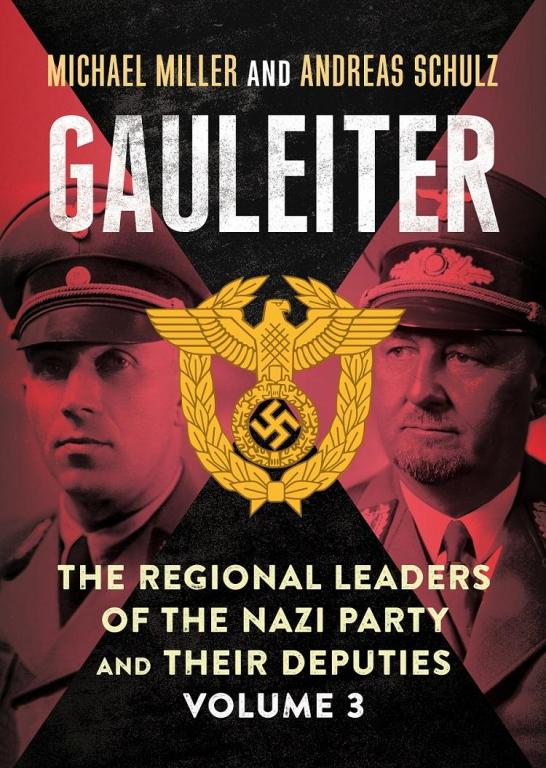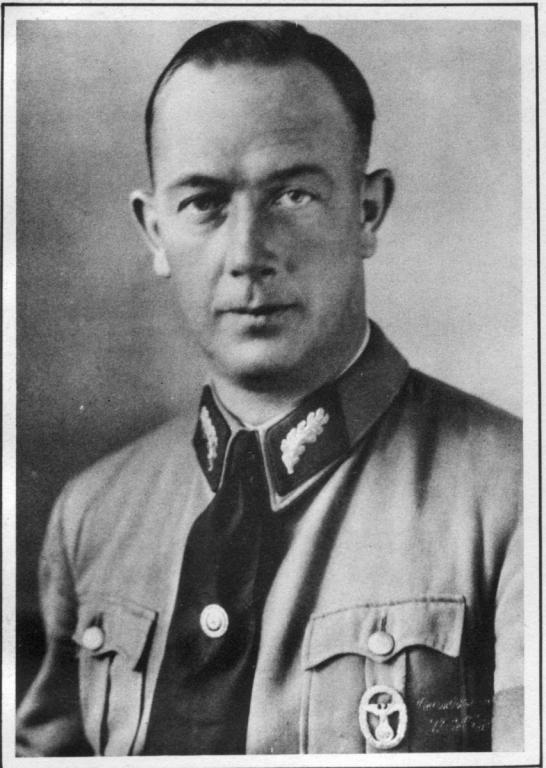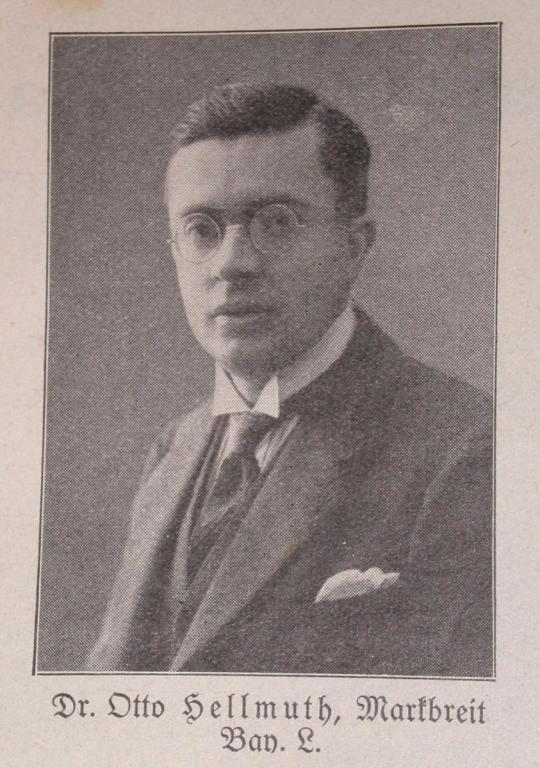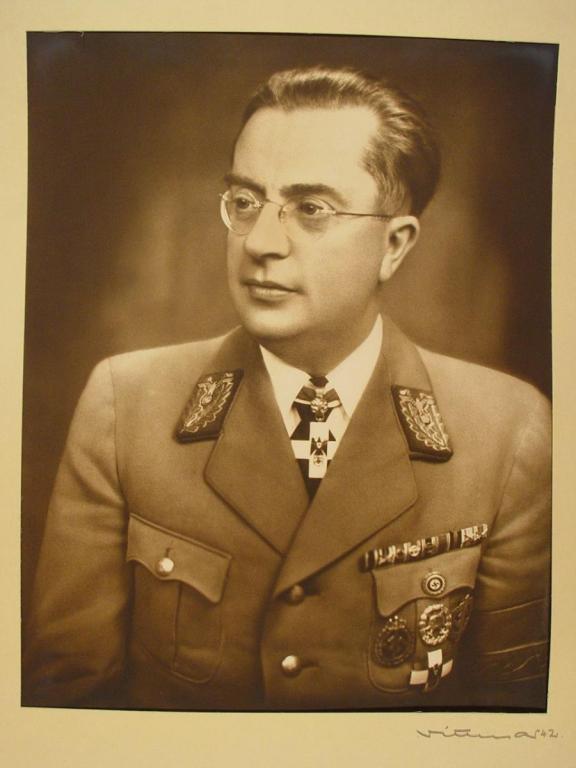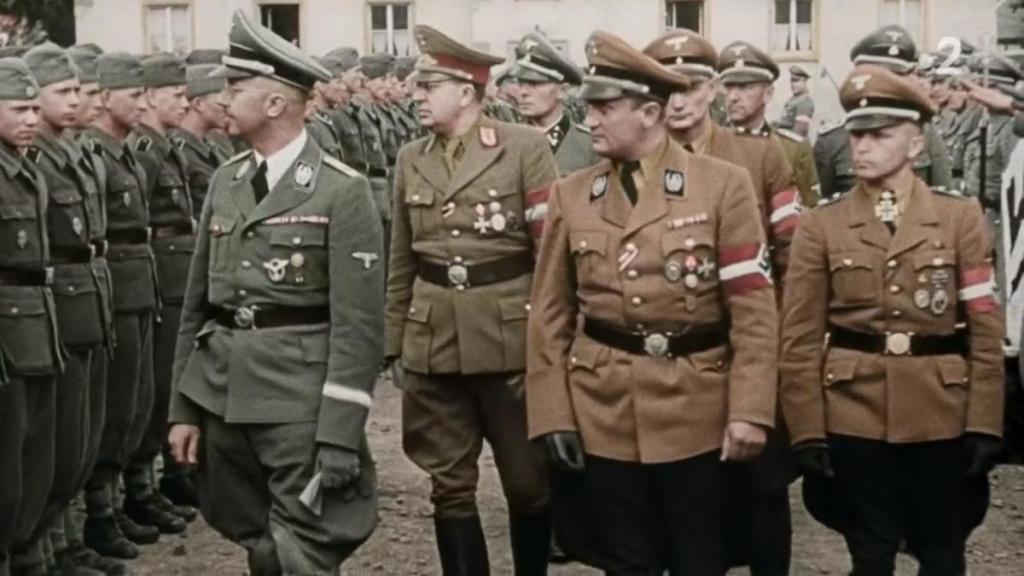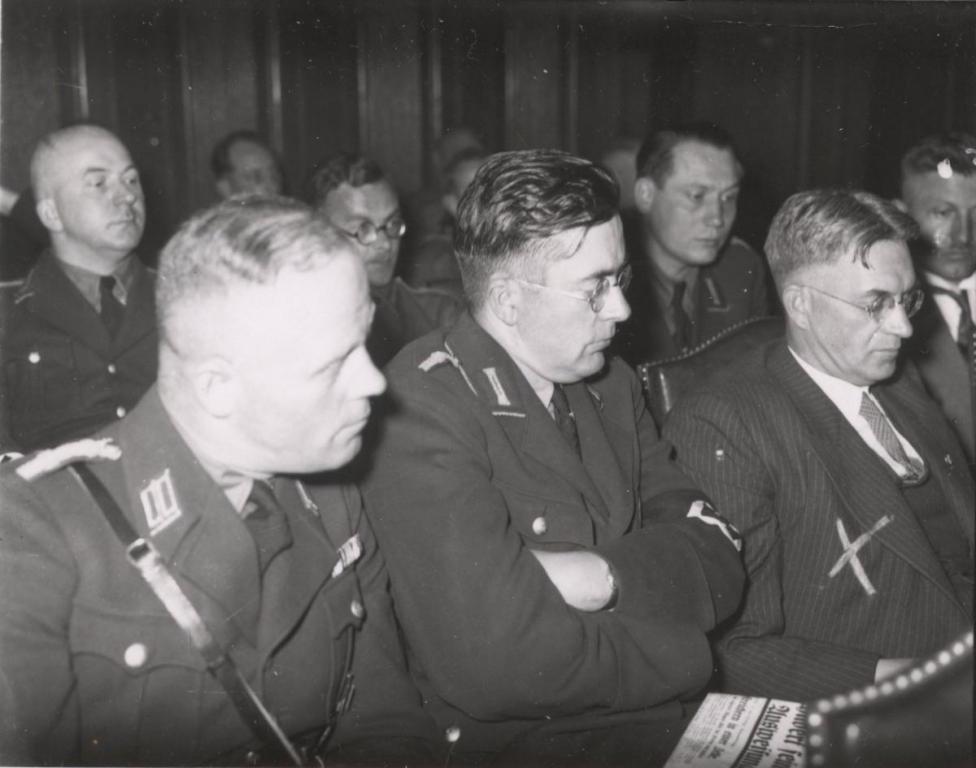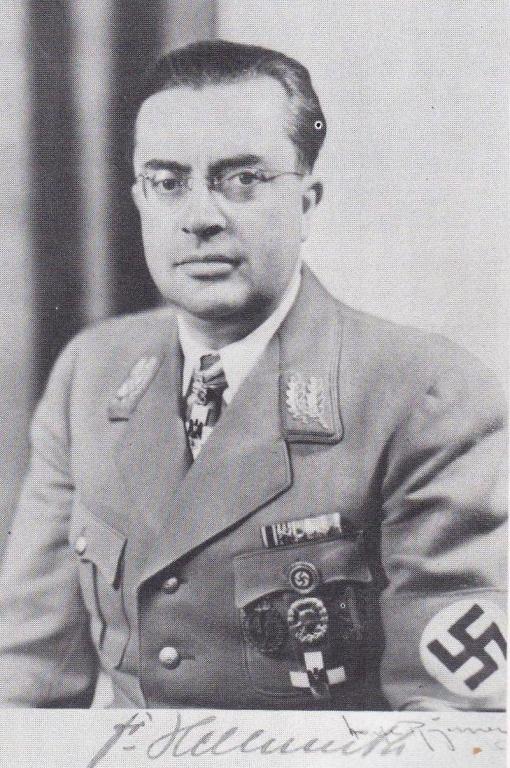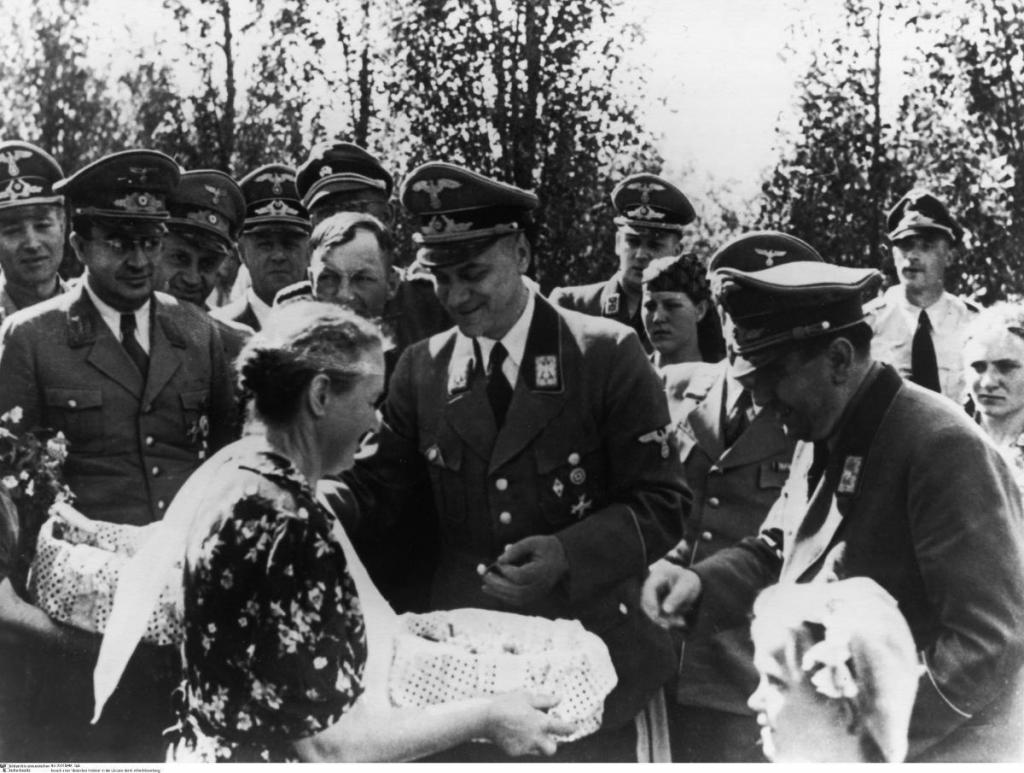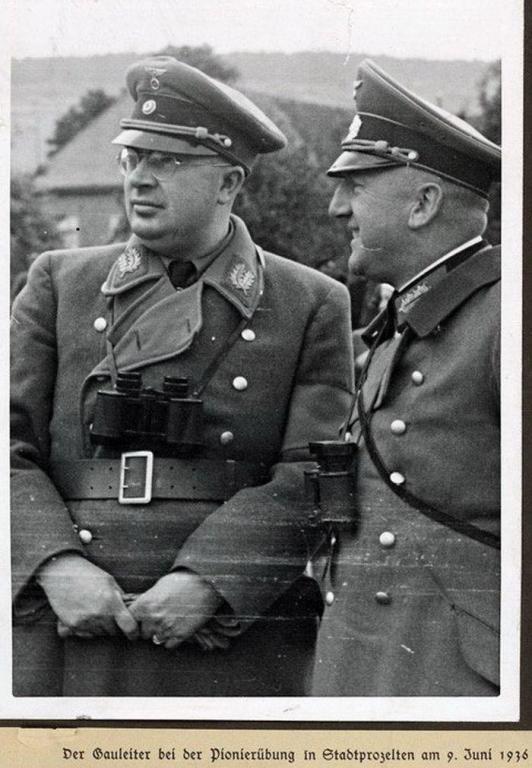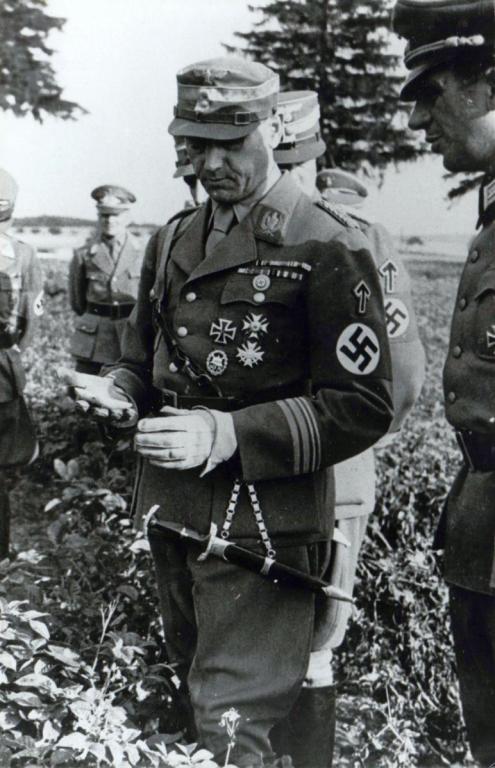
Michael D Miller
Basic Membership-
Posts
9 -
Joined
-
Last visited
Profile Information
-
Location
San Francisco
Recent Profile Visitors
The recent visitors block is disabled and is not being shown to other users.
Michael D Miller's Achievements
-
A bit more on him. His massively expanded biographical sketch will appear in the upcoming second edition, from Fonthill Media, of Leaders of the Storm Troops, Volume 1. Viktor Heinrich Lutze Stabschef der SA (30.06.1934-02.05.1943) * 28.12.1890 in Bevergern/Kreis Tecklenburg/Westfalen. † 02.05.1943 (at 2230 hours) during an operation at the Städtischen Krankenhaus, Potsdam, as a result of injuries sustained in an auto accident near Michendorf. This occurred at 1430 hours on 01.05.1943 as Lutze, his wife, his 17-year-old daughter Inge, oldest son Viktor Jr., and chauffeur were returning on the Reichsautobahn from Bevergern to Berlin. Viktor Jr. was reportedly driving and fell asleep at the wheel, the car then careening over an embankment, at in excess of 60 mph. Jill Halcomb, referencing a 03.05.1943 press report issued by Dr. Sommer, describes the accident as follows: Suddenly, from the grass median several pedestrians stepped into the path of Lutze's speeding car. The driver slammed on the brakes, and apparently hit some of the pedestrians. The sudden braking caused the car to change direction and roll with great velocity down the highway for more than fifty meters. Lutze was thrown against the windshield of the car. At first Lutze was not thought to be seriously injured, but late in the day he grew increasingly worse; a blood clot had formed in his lungs. He was rushed into surgery, but Lutze died soon after. His daughter, who had been riding in the rear seat of the car, died earlier, from her severe injuries. (Halcomb, The SA: A Historical Perspective, pp. 81-82) In a notice to the press, SA-Brigadeführer Thomas Girgensohn (Amtschef in the Adjutantur des Stabschefs der SA) wrote: On 1 May 1943, at about 14.30 hours., the Stabschef's car on the Reichsautobahn, in the curve forming the junction of the railroad from Hannover with that from Leipzig, hit the median, raised and cemented at this point, which separates the two carriageways. The vehicle was thrown out of the lane and crashed down the high embankment. The Stabschef, who as usual was in the front on the right side of the driver, was pressed against the windshield in such an unfortunate way that, in addition to serious injuries to the right shoulder, he suffered bruises, several broken ribs and a concussion. The injuries, the serious nature of which became apparent immediately during the first examination after his admission to the hospital [in Potsdam], did not immediately threaten the life of the Stabschef. In the course of Sunday, the Stabschef's condition worsened due to increasing obstruction of breathing and circulation... (SA-Personalakte Viktor Lutze) In his diary entry of 05.05.1943, Goebbels wrote: ... In fact, the car accident was due to improper speed and senseless driving by Lutze's son. Of course, one cannot say that in public; one would completely destroy the son with that... Despite intensive treatment by the renowned surgeon Prof. Dr. Ferdinand Sauerbruch, Dr. Otto Nordmann (the Lutz Family’s personal physician), and Dr. Werner Forßmann, clinic director of the städtischen Krankenhaus in Potsdam (a recipient, in 1956, of the Nobel Prize in Medicine for his work with cardiac catheterization), Lutze died at 2030 hours due to a collapsed lung. (“Stabschef Lutze schwer verletzt”, in Bremer Nachrichten, 03.05.1943; “Schwerter Kraftwagenunfall des Stabschefs Lutze”, in Völkischer Beobachter [Berlin], 03.05.1943) NSDAP-Nr.: 84 (Joined 21.02.1922 with a different number; Party banned, 09.11.1923-16.02.1925; Unofficially reenrolled 25.02.1925; Officially reentered the Party, 22.03.1926, and later granted the very low membership number of 84 “in Anerkennung seiner Verdienste” [in recognition of his meritorious service]) Promotions: 11.04.1907 Postgehilfe (Anwärter für die gehobene Postbeamtenlaufbahn) 28.12.1912 Postassistant 01.10.1912 Einjährig-Freiwilliger 00.00.191_ Unteroffizier [12.04.1916] Vizefeldwebel 00.00.191_ Leutnant d. R. 00.08.1919 Charakter als Oberleutnant d. R. 00.00.1919 Postsekretär 00.00.1923 SA-Mann 00.00.1925-00.00.1925 Stellvertretender Gauleiter der NSDAP 00.07.1925-26.09.1925 Gauleiter der NSDAP 27.09.1925 Gau-SA-Führer 00.06.1926-00.00.1927(?) Stellvertretender Gauleiter der NSDAP 01.03.1928 SA-Oberführer 02.04.1931 SA-Gruppenführer (Der Oberste SA-Führer, Führerbefehl Nr. 4, 14.10.1931) Reinstated at that rank, 01.07.1932, when the government ban on the SA was lifted) 01.01.1933 SA-Obergruppenführer (Der Oberste SA-Führer, Führerbefehl Nr. 10 [Neujahrs-Befehl], 15.12.1932) Formally granted this rank by Adolf Hitler, 04.01.1933) 15.02.1933-25.03.1933 Polizeipräsident 25.03.1933-29.05.1933 Stellvertretender Obrerpräsident 29.05.1933-28.03.1941 Oberpräsident 30.06.1934-02.05.1943 Stabschef der SA 20.07.1934-02.05.1943 Reichsleiter der NSDAP 30.01.1938 DRK-Generalhauptführer
-
Very belated apologies for the font color issue. Hopefully it works better this time. Here is my most up-to-date listing of Lutze's awards. Best wishes, ~ Mike 07.05.1943 Deutscher Orden des Groβdeutschen Reiches, I. Klasse, 1. Stufe mit Lorbeerkranz und Schwertern (4th recipient; posthumous award) 00.00.191_ 1914 Eisernes Kreuz I. Klasse 00.00.191_ 1914 Eisernes Kreuz II. Klasse 31.03.1941 Kriegsverdienstkreuz I. Klasse mit Schwertern 00.00.1940 (?) Kriegsverdienstkreuz II. Klasse mit Schwertern 19.01.1919 Fürstlich Lippisches Kriegsehrenkreuz für heldenmütige Tat 30.05.1919 Fürstlich Lippisches Offiziersehrenkreuz mit Schwertern 00.00.1918 Verwundetenabzeichen, 1918 in Silber 00.00.1939 Medaille zur Erinnerung an den 1. Oktober 1938 00.00.1939 Medaille zur Erinnerung an den 13. März 1938 ca. 1934 Ehrenkreuz des Weltkrieges 1914-1918 mit Schwertern 00.00.1933 Goldenes Ehrenzeichen der NSDAP 17.05.1939 Goldenes Hitler-Jugend Ehrenzeichen mit Eichenlaub Presented by Reichsjugendführer Baldur von Schirach. 30.01.1942 Dienstauszeichnung der NSDAP in Gold 30.01.1940 Dienstauszeichnung der NSDAP in Silber 30.01.1940 Dienstauszeichnung der NSDAP in Bronze 00.09.1933 Abzeichen “Reichsparteitag Nürnberg 1933” 00.00.1929 Nurnberger Parteitagsabzeichen 1929 00.00.1931 Abzeichen des SA-Treffens Braunschweig 1931 26.05.1933 Schlageter Gedächtnis-Abzeichen (Nr. 7) 00.00.193_ Groβkreuz des Ehrenzeichens des Deutschen Roten Kreuzes mit Eichenlaub (Halsorden) 10.06.1939 Ehrenzeichen des Roten Kreuzes der Freien Stadt Danzig. Presented by Danzig Senatspräsident Arthur Greiser during the “SA-Gruppenwettkämpfen in Danzig”. (“Senatspräsident Greiser überreicht Stabschef Lutze das Ehrenzeichen vom Roten Kreuz der Freien Stadt Danzig”, in Danziger Neueste Nachrichten, 12.06.1939) 20.10.1940 Kreuz von Danzig I. Klasse 24.08.1936 Deutsches Olympia-Ehrenzeichen I. Klasse 13.12.1939 Deutsche Schutzwall-Ehrenzeichen 26.06.1938 Silbernes Treudienst-Ehrenzeichen 00.00. 1936 Ehrenplakette für die Mitglieder des Reichskultursenats 00.00.193_ Deutsche Reiterabzeichen in Bronze 31.03.1941 Dankschreiben des “Führers” Letter of Appreciation from Adolf Hitler to honor his service as Oberpräsident of Hannover. 28.12.1937 SA-Ehrendolch für Führer der SA-Standarte “Feldherrnhalle” with the following inscription on the blade: Ihrem Stabschef im alten SA-Geist zum 28.12.1937 Das Führerkorps der Standarte Feldherrnhalle 28.12.1940 Ehrendolch des Deutschen Heeres (Honor Dagger of the German Army. Presented on the occasion of his 50th birthday by Generalfeldmarschall Walther von Brauchitsch. (“Stabschef Lutze 50 Jahre alt”, Hamburger Fremdenblatt, 27.12.1940; “Der Stabschef der SA”, in Frankfurter Zeitung, 28.12.1940; “Stabschef der SA Lutze 50 Jahre”, in Illustrierte Kronen-Zeitung [Wien], 28.12.1940; “Ein Lebenswerk für des Volkes Wehrkraft – Zum 50. Geburtstag des Stabschefs der SA”, in Ostdeutscher Beobachter [Posen], 28.12.1940) 03.02.1934 Ehrendolch der SA 00.00.1937 Gold-plated Walther PP 7.65 mm pistol with ivory grips bearing his initials- “VL” and serial number 972851. Engraved “Ehrengabe der Waffenfabrik Walther - Zella-Mehlis/Th.” and “S.A. - Pistolenschiessen 1937”. The weapon was manufactured by Carl Walther Waffenfabrik Zella-Mehlis/Thüringen. 28.12.1938 Luftwaffen-Zivilabzeichen (“Hermann Göring ehrt seinen Kampfgefährten Lutze”, in Das Kleine Volksblatt [Wien], 10.01.1939; “Göring ehrt Lutze”, in Pommersche Zeitung, 11.01.1939) 00.02.1934 Ehrenwinkel für alte Kämpfer 18.12.1931 Tyr-Rune 13.05.1939 Ehrenbürgerrecht der Stadt Schwelm (Revoked by the Rat der Stadt Schwelm, 25.08.1983) 13.05.1939 Ehrenbürgerrecht der Stadt Schwelm (title revoked by decision of the city council, 25.08.1983) 26.06.1937 Ehrenbürgerrecht der Stadt Göttingen (Title revoked by decision of the Hauptausschuss der Stadt Göttingen, 25.08.1952) 23.06.1936 Ehreburgerbrief der Stadt Gelsenkirchen (Presented 28.06.1936 by Oberbürgermeister Karl Böhmer) 07.10.1934 Ehrenbürgerbrief der Stadt Bevergern (“Chef des Stabes Viktor Lutze in seiner Heimat - Ueberreichung des Ehrenbürgerbriefes “, Münsterischer Anzeiger, 08.10.1934; “Die westfälische Heimat umjubelt den Chef des Stabes, Viktor Lutze”, in Völkischer Beobachter, 09.10.1934) 00.00.193_ Ehrenbürgerrecht der Stadt Hattingen (Ruhr) 00.00.193_ Ehrenbürgerrecht der Stadt Rinteln 00.00.1937 Order of Saints Maurice and Lazarus, Grand Cross (Gran Croce dell’Ordine dei Santi Maurizio e Lazzaro) 01.11.1937 Honor Dagger of the Milizia Volontaria per la Sicurezza Nazionale (M.V.S.N., Volunteer Militia for National Security) 01.07.1938 Photograph of Il Duce (Benito Mussolini) inscribed to “Al Camerato Viktor Lutze in Kameradschaft”) (“Abschied Lutzes von Mussolini”, in Völkischer Beobachter [Münchner Ausgabe], 04.07.1938) 00.00.193_ Österreichische Kriegserinnerungsmedaille 16.07.1918 Commander’s Cross of the Royal Bulgarian Military Service Order with War Decoration 30.09.1940 Grand Cross of the Royal Bulgarian Order of Civil Merit
-
My biographical sketch of Gauleiter Dr. Hellmuth (from Gauleiter, Volume 1 and addenda in Volume 2). Best wishes, ~ Mike Otto Konrad Hellmuth Gauleiter of Gau Mainfranken der NSDAP (07.08.1934-07.05.1945) Gauleiter of Untergau Unterfranken der NSDAP (01.10.1928-07.08.1934) * 22.06.1896 in Markt Einersheim/Bezirksamt Scheinfeld/Landkreis Kitzingen/Regierungsbezirk Unterfranken/Bayern. † 20.04.1968 in Reutlingen (Suicide?). NSDAP-Nr.: 22 815 (First joined 00.00.1922; Party banned, 09.11.1923-16.02.1925; Reenrolled, 03.12.1925) Promotions: 16.09.1914 kriegsfreiwilliger Rekrut 22.09.1915 überzähliger Gefreiter 03.03.1915 etatmässiger Unteroffizier 00.10.1934 Ehren-Gauarbeitsführer [00.00.1923] Ortsgruppenführer der NSDAP 01.10.1928-08.05.1945 Gauleiter der NSDAP 00.10.1934 Ehren-Gauarbeitsführer 05.09.1938 NSKK-Gruppenführer 09.11.1939 NSKK-Obergruppenführer Career: ca. 1902-ca. 1906 Volksschule in Markt Einersheim and Iphofen. ca. 1906-ca. 00.00.19_ Realschule and Oberrealschule in Kitzingen, Passau, and Marktbreit. 00.00.191_-00.00.1914(?) Handelsschule (business school). 16.09.1914 Entered service as a Kriegsfreiwilliger (with 1-year service obligation) and posted for training to Rekruten-Depot I/Ersatz-Bataillon/9. Kgl. Bayerisches Infanterie-Regiment (swore the oath of service, 11.10.1914). 22.11.1914-12.12.1914 Assigned to 1. Ersatz-Kompanie/Ersatz-Bataillon/9. Kgl. Bayerisches Infanterie-Regiment. 12.12.1914-31.12.1914 Deployed to the Western Front with 10. Kompanie/9. Kgl. Bayerisches Infanterie-Regiment. 31.12.1914 Fell ill (Gastroenteritis) and hospitalized in the following medical facilities: 31.12.1914-01.01.1915 Feldlazarett 9. 01.01.1915-16.01.1915 Lazarett Comine. 16.01.1915-27.01.1915 Lazarett Tourcoiny. 27.01.1915-01.03.1915 Vereinslazarett Gewerkschaftshaus in Aschaffenburg. 01.03.1915-28.04.1915(?) Assigned to Genesenden-Kompanie (convalescent company)/I. Ersatz-Bataillon/9. Kgl. Bayerisches Infanterie-Regiment. 28.04.1915-29.02.1916 Assigned to 7. Kompanie/Kg. Bayerisches Reserve-Infanterie-Regiment 4. 29.02.1916 Lightly wounded by shrapnel to the left knee and treated without hospitalization. 30.03.1916 Hospitalized due to illness (Cardiac Neurosis, Gastroenteritis, and Tuberculosis). 30.03.1916-29.04.1916 Lazarett Labry 29.04.1916-30.09.1916 Vereinslazarett Schweinfurt. 30.09.1916-31.10.1916 Vereinslazarett Würzburg. 31.10.1916-23.05.1917 Assigned to Ersatz-Bataillon/Kgl. Bayerisches Reserve-Infanterie-Regiment 4. 23.05.1917-30.05.1917 Assigned to 2. Kompanie/Kgl. Bayerisches Reserve-Infanterie-Regiment 4. 30.05.1917-05.11.1917 Assigned to 3. Kompanie/Kgl. Bayerisches Landwehr-Infanterie-Regiment 8, then removed from the frontlines. 05.11.1917-19.12.1917(?) Assigned to bayerische Kriegslazarett-Abteilung 43. 19.12.1917-27.07.1918 Assigned to frontline service with 3. Kompanie/Kgl. Bayerisches Landwehr-Infanterie-Regiment 8. 27.07.1918-14.09.1918 Assigned to 2. Kompanie/Ersatz-Bataillon/Kgl. Bayerisches Landwehr-Infanterie-Regiment 8 (Landau/Pfalz). 14.09.1918 Took his Abitur exam at a Realgymnasium in Freiburg im Breisgau, then discharged from military service and returned to Marktbreit (Bezirksamt Kitzingen). 00.04.1919-00.00.1922 Studied dentistry at the Universities of Freiburg and Würzburg. 00.00.1919-00.00.1919 Member of the Volkswehrregiment Würzburg, with which he served against the München “Räterepublik”. 00.00.1919-00.00.1922 Member of the Deutschvölkischer Schutz- und Trutzbund, distributing anti-Semitic leaflets of this organization in Würzburg. 00.00.1920-00.00.1923 Founder and leader of the small völkisch Wehrverband (defense formation) “Bund Frankenland” in Würzburg. This was a satellite of the Brigade Ehrhardt which was later integrated into the SA. 00.00.1922 Received his doctorate (Dr. med. dent.), then practiced as a dentist in Markt Einersheim and Marktbreit. 00.00.1922 Joined the NSDAP. 14.-15.10.1922 Participated in the “3. Deutscher Tag” in Coburg. [00.00.1923]-00.00.1923 Ortsgruppenführer of Ortsgruppe Pappenheim der NSDAP. 06.04.1924 Unsuccessful candidate of the Völkischen Block for election to the Bayerische Landtag. 05.04.1925 Cofounder of the Ortsgruppe Würzburg der NSDAP. 03.12.1925 Officially reenrolled in the NSDAP. 00.00.1926-00.00.1933 Stadtrat in Marktbreit 20.05.1928-14.10.1933 Member of the Bayerische Landtag (representing Wahlkreis Unterfranken). 01.10.1928-07.08.1934 Gauleiter of Untergau Unterfranken der NSDAP (Seat: Würzburg). Upgraded as a Gau, ca. 1929, and redesignated Gau Mainfranken der NSDAP, 07.08.1934. 30.04.1929 Organized a mass meeting in Würzburg’s Huttenschen Garten to protest the murder of 4-year-old Karl Kessler. The boy had been killed by an unknown person in Manau bei Hofheim/Unterfranken on 17.03.1929. In response, Hellmuth had, as a special correspondent of Julius Streicher’s Der Stürmer, written an article alleging that the Kessler boy had been slaughtered by Jews who used his blood in the baking of matzoh. As a result, the homicide case became known to the public as the “Ritualmord von Manau”, however the local police rejected the ritual murder accusations. In later years, Dr. Hellmuth blamed two specific Jews- a religion teacher and a butcher- for the crime. Despite a Gestapo investigation of these men, their guilt could not be established. 00.00.19__-00.00.19__ Editor of the newspapers Mainzeitung, Marktbreiter Wochenblatt, Volksstimme, Der Franke, Die Hilfe, Nationalstimme, Freiheit, Fränkisches Volk, and Mainfränkische Zeitung. 19.11.1930 Organized a protest rally against the planned performance in the Würzburg State Theatre of An-Ski’s play “Dybuk” by the Jewish Moscow Sate Theatre “Habima”. 14.07.1931 Expelled from the Bayerische Landtag for eight meeting days due to improper behavior. 00.00.1932 Appointed as a member of the Führerrat der deutschen Zahnärzteschaft (Leadership Council of the Organization of German Dentists). 11.03.1933 Three weeks before the nationwide Nazi boycott of Jewish-owned businesses, ordered the temporary closure of Jewish shops, offices, and practices in Würzburg. 12.11.1933-08.05.1945 Member of the Reichstag (Wahlkreis 26, Franken). 11.04.1934-01.07.1934 Politischer Beauftragter der Bayerischen Staatsregierung (Political Representative of the Bavarian State Government) and Politischer Leiter der Kreisregierung Unterfranken (Political Director of the District Government for Unterfranken). 01.07.1934-08.05.1945 Regierungspräsident of Unterfranken and Aschaffenburg (after 1938, these regions were together redesignated as Mainfranken). 00.00.1934-00.00.19__ Editor of the newspapers Fränkische Volks-Nationalstimme, Braune Sonntagspost, and Aschaffenburger Zeitung. 00.00.1934-ca. 1941 Coordinator of the “Dr.-Hellmuth-Plan zur Neuordnung des Gaues Mainfranken” (Dr. Hellmuth Plan for the Reorganization of Gau Mainfranken”), aimed at restructuring the Rhön River hills and the Spessart hill chain located within his jurisdiction in northwestern Bayern. He conceived the plan together with his Gauwirtschaftsberater (Gau Economic Advisor), Kurt Hasslinger, who described the situation in the poorly developed and impoverished Rhön and Spessart, with a population of about 250,000, as “a disgrace to civilization”. Dr. Hellmuth toured the area around the Rhön in October 1933, observing, as Dan Silverman writes, the “extent of disease, poverty, and general social disintegration and degeneration (including incest) [in the region].” (Silverman, Hitler’s Economy: Nazi Work Creation Programs, 1933-1936, p. 99). In line with Nazi population policy, this might have suggested that the people living in the region would be deemed biologically and socially unfit for membership in the “Volksgemeinschaft”; and in fact, sterilization and even “euthanasia” were considered. However, Hasslinger wrote: “To begin with, it was established through random sampling that the Rhön population is one of the most valuable parts of the entire German people. This determination was then confirmed in its correctness through systematic investigations of the Gau Race Policy Office. Using the methods of the president [of the Thuringian Health Office] Professor Dr. [Karl] Astel, Weimar, the entire genealogical structure of the population was ascertained.” (ibid) With the majority population being deemed “Nordic” by racist pseudo scientists, Dr. Hellmuth’s plan would- in addition to rebuilding the wretched economy of the region- “remove the minority of the population deemed to be racially or biologically unfit.” (ibid, p. 100) The program was very comprehensive, encompassing a multitude of industrial, agricultural, transportation, and social problems. It was, however, overly ambitious and beset by numerous obstacles, as Jeremy Noakes writes in the following passage: It envisaged the resettlement of the large number of uneconomic smallholdings with larger, economically viable, productive hereditary farms (Erbhöfe) operated by racially sound proprietors instead of the physically and spiritually debilitated existing population. However, although the scheme appeared to reflect many of the key principles of Nazi ideology and despite official acknowledgement of the problems of the Rhön, in the end little of the ‘Dr. Hellmuth Plan’ was realised. The high cost of the ambitious programme, the scepticism of the Reich authorities in Berlin [notably Reich Food & Agriculture Minister R. Walther Darre, who was reluctant to offer the necessary support to this very expensive undertaking- Hellmuth’s and Hasslinger’s calculations for costs in the Rhön area alone amounting to RM 35 Million], objections from the minister-president of neighbouring Thuringia [Willy Marschler], which contained part of the Rhön, and the local population’s opposition to losing their land and being forcibly relocated combined to prevent its realisation... (Noakes, “Viceroys of the Reich?”, in Working Towards the Führer: Essays in Honour of Sir Ian Kershaw, p. 141) 00.10.1934 Awarded the title of Ehren-Gauarbeitsführer. 08.04.1936 Established an Ehrenkarte für die deutsche Mutter (Certificate of Honor for German Mothers) to recognize these women as the “Lebensborn des deutsches Volkes” (Foundation of Life of the German People). This was over two years before Hitler’s foundation of the Deutsche Mutterkreuz (German Mothers Cross) on 16.12.1938. A prerequisite of the award was that the mother must be of “German blood,” and have given birth to at least four “erbgesunden Kindern” (children free of hereditary disease and to able to reproduce. 00.09.1935-00.00.1944 Member of the Akademie für Deutsches Recht, München. 00.00.1936 By dubious means, took possession of a villa- owned by the Jewish pharmacist Max Mandelbaum (who had emigrated with his family)- at Ludendorffstrasse 26 in Würzburg. In his capacity as Regierungspräsident, he compelled the city to purchase the property for the low price of 100.000 Reichsmark, whereupon the city sold it to him for 80.000 Reichsmark. The mansion was used by Hellmuth as a meeting place for the NSDAP. He lived in great luxury with his family here. Documents of the Würzburg Arbeitsamt (labor office) reveal that he had a household staff of 28 servants. Dr. Hellmuth appears to have spent much of his time building up a lavish lifestyle at Party expense. When he requested that the Reich Treasury office provide funds of RM 22,246 to purchase a Mercedes, the Party Treasurer, Reichsleiter Franz Xaver Schwarz, responded, on 19.01.1937, by limiting the amount to RM 15,000. 00.04.1938 Delivered a speech on the Adolf-Hitler-Feld in front of the Florian Geyer ruins in Giebelstadt in which he declared: I vow to you, my Führer, to use the abundant cultural and freedom-fighting tradition of my Gau to make it strong and pure and to ensure that it will be a district of no worries for our Führer. Mainfranken, Gau rich in farming tradition, will become and must be: Adolf Hitler’s own Sanssouci! Sieg Heil!” 05.09.1938-00.05.1945 Granted the honorary rank of NSKK-Gruppenführer, with attachment to the staff of NSKK-Motorobergruppe Mitte. 17.02.1939 “mit den städtebaulichen Massnahmen für Würzburg beauftragt” (Charged with municipal construction measures for the City of Würzburg). 00.00.1939 Appointed as Vorsitzender of the Mainfränkischen Gemeinschaftswerk (in the “Dr. Hellmuth-Plan”). 22.09.1939-08.05.1945(?) Member of the Verteidigungsausschuss of WehrKreises XIII. 00.00.193_-00.00.19__ Member of the Vorstand, Fränkische Tiefbohr GmbH, München. 00.00.193_-00.00.19__ Member of the Aufsichtsrat of Ueberlandwerk Mainfranken AG, Würzburg. 00.00.193_-00.00.19__ Leiter of Abawerke GmbH Präzisions-Werkzeugfabrik, Aschaffenburg (charged with leadership of this company by the Reichswirtschaftsministerium. 23.09.1940 On a visit to the Heil- und Pflegeanstalt [sanatorium and care home] of Werneck, demanded that it be cleared immediately and confiscated it for accommodating ethnic German settlers from Bessarabia. Between 03.06. and 06.10.1940 a total of 777 patients were removed from Werneck. Half went to the Heil- und Pflegeanstalt at Lohr am Main and the other half by way of various transit institutions to killing centers, designated for the “euthanasia” of the physically and mentally disabled by “Aktion T4” , such as Schloss Sonnenstein in Pirna and Schloss Hartheim near Linz, where they were gassed. The patients were evacuated by Gemeinnützige Krankentransport GmbH (Gekrat), Berlin, a cover organisation for “Aktion T4” run from the Führerkanzlei. During the evacuation, Hellmuth ensured that the patients would be moved back to Werneck once the resettlement of the Volksdeutschen had been completed. After a short time, relatives of the sick, who had not been informed of the move, began to receive the first news of their deaths from the euthanasia institutes. About two months after being moved away, all the patients who had been moved out of Mainfranken were dead. On 24.10.1940 the Heil- und Pflegeanstalt of Werneck was occupied by Bessarabian Germans, who were to emigrate into the Reich from there. 15.11.1940-08.05.1945 Gauwohnungskommissar for Gau Mainfranken. 27.11.1941-17.08.1943 According to a summary report of the Gestapo dated 06.08.1943, entitled “Evacuations of Jews from Mainfranken”, 2,063 Jews were deported from Dr. Hellmuth’s Gau during this period. The “evacuations” were carried out in a total of seven transports, six departing from Würzburg and one from nearby Kitzingen. The Würzburg deportations occurred as follows: Date Destination 27.11.1941 Riga 23.03.1942 Izbica (Lublin Distrikt) 25.04.1942 Izbica 10.09.1942 Theresienstadt 23.09.1942 Theresienstadt 17.08.1943 Auschwitz-Birkenau 06.04.1942-08.05.1945 Beauftragter des GBA für den Gau Mainfranken (Representative of the Generalbevollmächtigter für den Arbeitseinsatz [Plenipotentiary General for Labor Allocation, Gauleiter Fritz Sauckel] for Gau Mainfranken). 16.11.1942-08.05.1945 Reichsverteidigungskommissar für den Gau Mainfranken (Reich Defense Commissioner for Gau Mainfranken). In this capacity, he had a concrete bunker built as a Befehlstelle (command post) near his villa Am letzten Hieb to which he, together with his family and members of his staff, would retreat during Allied air raids. During a major air raid by 280 RAF bombers on Würzburg on 16.03.1945 (1,200 high explosive and 380,000 incendiary bombs, totaling 927 tons, were dropped, killing between 3,000 and 5,000 people, rendering 90,000 homeless, and caused extensive damage to the city), Dr. Hellmuth was absent from the city. 07.02.1943 At Führer HQ “Wolffschanze” in Rastenburg/Ostpreußen, during which Hitler addressed most of the Reichs- and Gauleiter on the subject of the recent German defeat at Stalingrad. June 1943 Together with Dr. Siegfried Uiberreither (Gauleiter of Steiermark), accompanied Reichsminister Alfred Rosenberg on his 18-day trip through the Ukraine and the Crimea, during which they met with Reichskommissar/Gauleiter Erich Koch [with whom they inspected the Deutsche Schule in Halbstadt on 19.06.1943] and Generalkommissar Alfred Eduard Frauenfeld. ca. Sep. 1944 According to Time magazine, issue of 18.09.1944, declared the following in a speech to the people of Würzburg: We all know that God is with us, but let’s not rely on God alone. Let’s work so hard and fight so fiercely that God cannot refuse to hand the victory palm to Germany. 25.09.1944-08.05.1945 Führer des Deutschen Volkssturms im Gau Mainfranken. 19.03.1945 Declaration by Dr. Hellmuth appearing on the front page of the Mainfränkischer Zeitung: Steadfast and hateful, we stand by our duty. We know only one thing: To do everything [necessary], for the day of vengeance comes. ca. 26.03.1945 Meeting with Albert Speer, who writes of this event as follows: In Würzburg I called on Gauleiter Hellmuth, who invited me to an ample breakfast... the Gauleiter explained with the greatest matter-of-factness that to carry out Hitler’s [“Nero”] decree he had ordered the destruction of the Schweinfurt ball-bearings industry... At first I could not convince him that such destruction was foolish. He asked me when the Führer intended to apply the decisive secret weapon. He had heard, from Bormann and Goebbels, that commitment of this weapon was impending. As I had done so often, I had to tell him that this secret weapon did not exist. I knew that this Gauleiter was one of the sensible ones and pleaded with him not to carry out Hitler’s scorched earth order. Given the situation, I argued, it was madness to deprive the people of the foundations for a continual national life by demolishing facilities and bridges. I also mentioned the German troops that were being concentrated east of Schweinfurt to counterattack in the center and recapture our armaments industries. In saying this I was not even lying, for the top leadership was actually planning a counterattack in the near future. The tired old argument that Hitler could not continue his war without ball bearings finally had its effect. Convinced or not, the Gauleiter was not eager to win immortal fame for having ruined all chance of victory by destroying the Schweinfurt factories. (Speer, Inside the Third Reich, pp. 368-369) 28.03.1945 In his last public appeal to the population of Gau Mainfranken, made shortly before the U.S. Army entered Würzburg, declared: The situation is serious but not at all hopeless! The leadership is taking all the steps that the situation requires. The hour of our testing has come! Whoever forgets his duty for just one second, is a traitor to the people. Cowards are to be ruthlessly done away with! There must only be room in our hearts for hatred and the will from determined resistance. They enemy shall report from Mainfranken that here too he met a determined and brave people! 02.04.1945 Fled with his family and the staff of his Gauleitung, as well as the Oberbürgermeister of Würzburg, Theo Memmel, to Untermerzbach bei Ebern; the city was occupied by the U.S. Army’s 42nd Infantry Division on 04.04.1945. From Untermerzbach, he and his entourage proceeded to Eggolsheim bei Forchheim in the Fränkischen Schweiz (a region of Oberbayern), where they arrived on 09.04.1945. Shortly before Hellmuth’s undignified and hypocritical departure, Dr. Goebbels had written the following in his diary: 29.03.1945: In the morning we got a report from Würzburg which sounded somewhat hopeful. The Gauleitung reports that they are in control of the situation these and that Aschaffenburg has again been cleared of the enemy. Our Reichspropagandaamtsleiter, Dr. Fischer, was particularly benevolent to those who raised the white flag when they enemy approached. In Gau Mainfranken they will receive the harsh treatment that they deserve. 02.04.1945: It is pleasing to hear that even the Wehrmacht admits that Gauleiter Hellmuth and Gerland have conducted themselves superbly. They are organizing one center of resistance after another and as a result are creating a far better situation in their Gaue than in the other Gaue of the West. I would have expected this from Gerland anyway but as far as Hellmuth is concerned one can say: people rise to the occasion. Hellmuth has always been a most retiring, unassuming Gauleiter in whom one had not too much confidence. Now, however, it is clear that there is more to him than one thought. Postwar Flight, & Prosecution: 00.05.1945-00.05.1945 Fled to the Tirol, leaving his wife and children in Oberbayern, and arrested there by U.S. troops later that month. 00.05.1945-00.05.1947 Escaped from U.S. captivity and lived in hiding for two years, during which he worked as a farm laborer in the Kassel area and went on to practice dentistry under the assumed name “Hans Oster” in Bassum near Bremen. 00.05.1947 Discovered by U.S. authorities in Wasum/Niedersachsen, then arrested and confined to the U.S. internment camp in Regensburg. During his first months of captivity, he attempted suicide and scrawled “Heil Hitler in blood on the wall of his cell. 18.09.1947-10.10.1947 Tried by the U.S. Military Tribunal at Dachau and sentenced to death by hanging for the murder of captured U.S. airmen during the war. The chief witness of the prosecution against him was the Kreisleiter of Neustadt, Andreas Ingebrand. Dr. Hellmuth was specifically convicted of the murder of four USAAF members who had been shot on 12.09.1944 by a Würzburg “Jagdkommando” (hunting unit, tasked with tracking down and killing enemy “terror fliers”) and the murder, by Kreisleiter Ingebrand, of a fifth American airman on 29.09.1944. On 23.10.1947, Bishop Matthias Ehrenfried of Würzburg, who had suffered from the anti-clerical policies of Gauleiter Hellmuth, submitted a plea for clemency to the court. This he did on behalf of Hellmuth’s sister, Hedwig (whom the Bishop described as “a good Catholic woman”). The death sentence was commuted to life imprisonment, and further reduced to 20 years in 1951. He was released, for “good behavior”, from U.S. War Criminals Prison No. 1 at Landsberg am Lech on 18.06.1955. He settled in Kassel in 1956. By 1958, he had returned to work as a practicing dentist (in Reutlingen). In January 1961, the Amtsgericht of Kassel authorized Hellmuth a Haftentschädigung (detention remuneration for his time as a prisoner of war!) of 5.160,-DM. Decorations & Awards: 02.03.1918 1914 Eisernes Kreuz II. Klasse 00.00.1941 Kriegsverdienstkreuz I. Klasse ohne Schwerter 00.00.1941 Kriegsverdienstkreuz II. Klasse ohne Schwerter 10.08.1918 Verwundetenabzeichen, 1918 in Silber 30.06.1918 Verwundetenabzeichen, 1918 in Schwarz ca. 1939 Medaille zur Erinnerung an den 1. Oktober 1938 ca. 1938 Medaille zur Erinnerung an den 13. März 1938 ca. 1934 Ehrenkreuz des Weltkrieges 1914-1918 mit Schwertern ca. 1933 Goldenes Ehrenzeichen der NSDAP 00.10.1932 Coburger-Abzeichen 1922 00.00.1933 Traditions-Gauabzeichen 00.00.194_ Dienstauszeichnung der NSDAP in Silber 00.00.194_ Dienstauszeichnung der NSDAP in Bronze 00.00.193_ Ehrenzeichen des Deutschen Roten Kreuzes I. Klasse mit Eichenlaub 00.00.193_ Verdienstkreuz des Deutschen Roten Kreuzes 00.00.193_ SA-Sportabzeichen 00.00.193_ Ehrenwinkel für alte Kämpfer 00.03.1941 Ehrenbürgerurkunde der Gemeinde Marktheidenfeld 00.00.1934 Ehrenbürgerrecht der Stadt Lohr am Main 06.08.1933 Ehrenbürgerrecht der Stadt Neustadt an der Saale 11.10.1933 Ehrenbürgerrecht der Stadt und Bezirk Brückenau 14.08.1938 Willkommensurkunde (certificate of welcome) from the Ortsgruppe Lautergrund der NSDAP, on the occasion of the “Kreistreffen in Ebern” and signed by Ortsgruppenleiter Burtellmann Notes: * Parents: - Father: Oberbahnmeister Konrad Hellmuth. - Mother: Therese Hellmuth, née Kraft. * Religion: Catholic. * Married in the Wenzelsaal of the Würzburger Rathaus on 13.06.1936 to Dr. med. dent. Erna Maria Stamm (Witnesses: Alfred Rosenberg and Franz Ritter von Epp). The ceremony was conducted by his deputy Gauleiter, Ludwig Pösl. Three children were born to the marriage, including a son born in November 1938). Sources: Brozsat, Martin; Fröhlich, Elke: & Wiesemann, Falk: Bayern in der NS-zeit. Oldenbourg Wissenschaftsverlag, 1983. Goebbels, Dr. phil. Paul Joseph: Final Entries 1945: The Diaries of Joseph Goebbels (edited by Prof. Hugh Trevor-Roper, Translated from the German by Richard Barry). Putnam, 1978. Hamilton, Charles: Leaders and Personalities of the Third Reich, Volume I. R. James Bender Publishing, 1984. Höffkes, Karl: Hitlers politische Generale: Die Gauleiter des Dritten Reiches. Grabert-Verlag-Tübingen, 1986. Kienast, Ministerialdirigent Ernst (Editor): Der Groβdeutsche Reichstag, IV. Wahlperiode, Beginn am 10.04.1938 verlängert bis zum 30. Januar 1947. Berlin, November 1943. Lilla, Joachim & Schulz, Andreas: Statisten in Uniform. Die Mitglieder des Reichstags 1933-1945. Droste Verlag, 2004. Silverman, Dan P.: Hitler’s Economy: Nazi Work Creation Programs, 1933-1936. Harvard University Press, 1998. Speer, Albert: Inside the Third Reich. Macmillan, 1970. Stockhorst, Erich: 5000 Köpfe: Wer war was im 3. Reich (3rd Edition). Arndt-Verlag, 1998.
-
I'm now able to add the following to his awards list: 00.00.1937 Gold-plated Walther PP 7.65 mm pistol with ivory grips bearing his initials- “VL” and serial number 972851. Engraved “Ehrengabe der Waffenfabrik Walther - Zella-Mehlis/Th.” and “S.A. - Pistolenschiessen 1937”. The weapon was manufactured by Carl Walther Waffenfabrik Zella-Mehlis/Thüringen.
-
Just resurrecting this thread from long ago, as I'm reworking Lutze's biographical sketch for the eventual new and improved Leaders of the Storm Troops, Volume 1. Here's the most up-to-date list I have of his awards. Any corrections or additions would be appreciated. 08.05.1943 Goldenes Kreuz des Deutschen Ordens (posthumous award) 00.00.191_ 1914 Eisernes Kreuz I. Klasse 00.00.191_ 1914 Eisernes Kreuz II. Klasse 31.03.1941 Kriegsverdienstkreuz I. Klasse mit Schwertern 00.00.1940 (?) Kriegsverdienstkreuz II. Klasse mit Schwertern 19.01.1919 Fürstlich Lippisches Kriegsehrenkreuz 30.05.1919 Fürstlich Lippisches Offiziersehrenkreuz mit Schwertern 00.00.1918 Verwundetenabzeichen, 1918 in Silber ca. 1939 Medaille zur Erinnerung an den 1. Oktober 1938 ca. 1938 Medaille zur Erinnerung an den 13. März 1938 ca. 1934 Ehrenkreuz des Weltkrieges 1914-1918 mit Schwertern 00.00.1933 Goldenes Ehrenzeichen der NSDAP 17.05.1939 Goldenes Hitler-Jugend Ehrenzeichen mit Eichenlaub (presented by Reichsjugendführer Baldur von Schirach) 30.01.1942 Dienstauszeichnung der NSDAP in Gold 30.01.1940 Dienstauszeichnung der NSDAP in Silber 30.01.1940 (?) Dienstauszeichnung der NSDAP in Bronze 00.09.1933 Abzeichen “Reichsparteitag Nürnberg 1933” 00.00.1929 Nurnberger Parteitagsabzeichen 1929 00.00.1931 Abzeichen des SA-Treffens Braunschweig 1931 00.00.1933 Schlageter Gedächtnisabzeichen (Nr. 7) 00.00.193_ Ehrenzeichen des Deutschen Roten Kreuzes I. Klasse 20.10.1940 Kreuz von Danzig I. Klasse 24.08.1936 Deutsches Olympia-Ehrenzeichen I. Klasse 13.12.1939 Deutsche Schutzwall-Ehrenzeichen ca. 1936 Ehrenplakette für die Mitglieder des Reichskultursenats 00.00.193_ Deutsche Reiterabzeichen in Bronze 31.03.1941 Dankschreiben des “Führers” (Letter of Appreciation from the Führer, Adolf Hitler) 28.12.1937 SA-Ehrendolch für Führer der SA-Standarte “Feldherrnhalle” 28.12.1940 Ehrendolch des Deutschen Heeres (Honor Dagger of the German Army; presented on the occasion of his 50th birthday by Generalfeldmarschall Walther von Brauchitsch) 00.00.1934 Ehrendolch der SA (mit Wirkung vom 03.02.1934) 28.12.1938 Luftwaffen-Zivilabzeichen 00.02.1934 Ehrenwinkel für alte Kämpfer ca. 1932 Tyr-Rune 13.05.1939 Ehrenbürgerrecht der Stadt Schwelm (title revoked by decision of the city council, 25.08.1983) 26.06.1937 Ehrenbürgerrecht der Stadt Göttingen (title revoked by decision of the Hauptausschuss der Stadt Göttingen, 25.08.1952) 08.10.1934 Ehrenbürgerbrief der Stadt Bevergern 00.00.1937 Order of Saints Maurice and Lazarus, Grand Cross (Gran Croce dell’Ordine dei Santi Maurizio e Lazzaro) 01.11.1937 Honor Dagger of the Milizia Volontaria per la Sicurezza Nazionale (M.V.S.N., Volunteer Militia for National Security) 00.00.193_ Österreichische Kriegserinnerungsmedaille 16.07.1918 Commander’s Cross of the Royal Bulgarian Military Service Order with War Decoration 30.09.1940 Grand Cross of the Royal Bulgarian Order of Civil Merit


